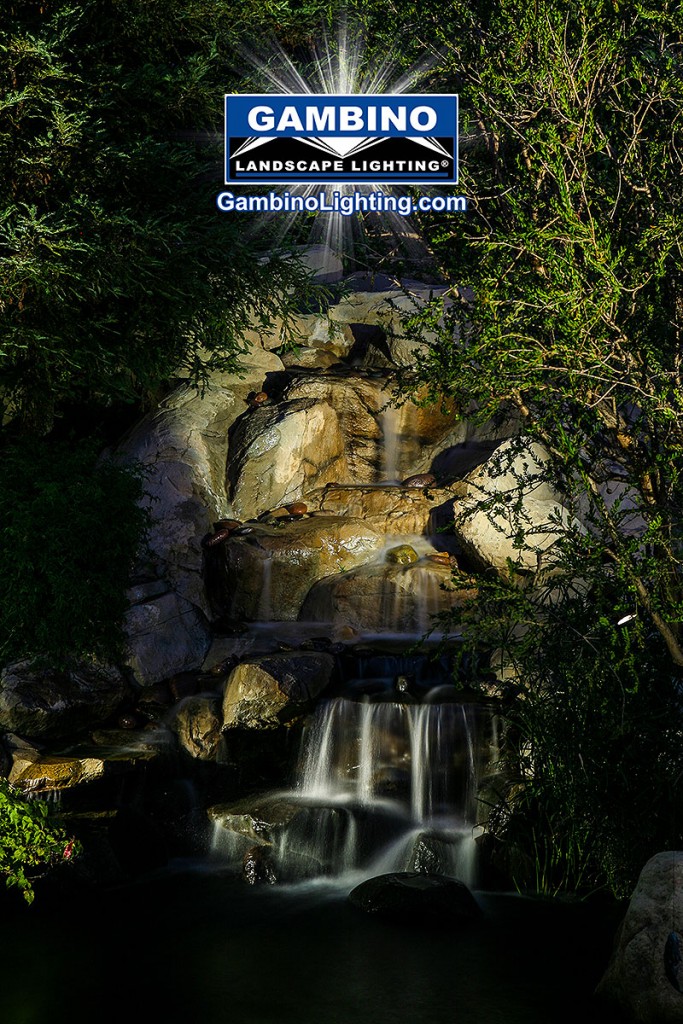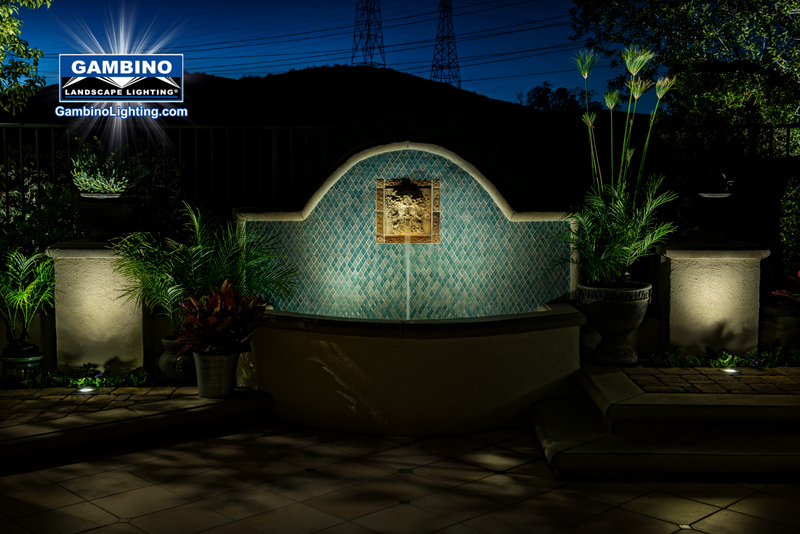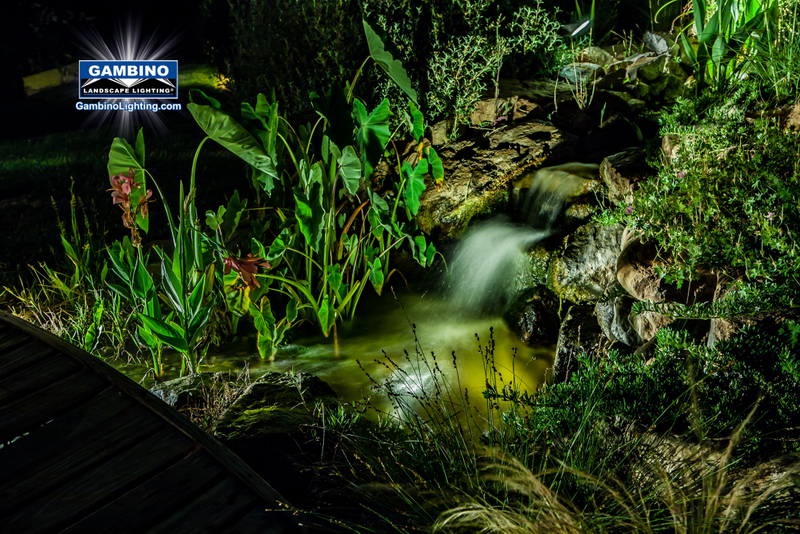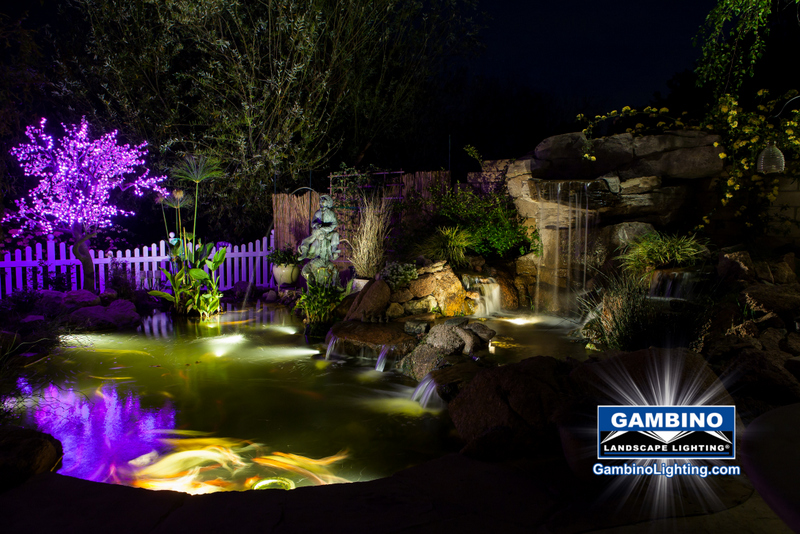03 Feb Combing Water and Lighting techniques for maximum Night time Effect
By Mike Gambino
For many people, the majority of daylight hours are consumed by work, travel, family time or other commitments. With residential water features, owners should consider the time when most likely they will actually be able to enjoy them. Often it is well after dinnertime before there is a chance to relax. Adding lighting to a water feature can extend the time available for homeowners to enjoy it. Choosing the appropriate type of fixtures and implementing a few techniques will provide a successful water feature lighting design.
 With wide-beam fixtures, waterfalls can be lit from the front by centering the beam on the cascading water. Placing the fixture just below the surface will maximize illumination of the waterfall.
With wide-beam fixtures, waterfalls can be lit from the front by centering the beam on the cascading water. Placing the fixture just below the surface will maximize illumination of the waterfall.
 Fixture Choice
Fixture Choice
Low-voltage underwater lighting is the most popular type used in residential water features. Like traditional landscape low-voltage lighting systems, underwater low-voltage systems use a transformer to power numerous fixtures. The most appropriate are transformers with proper electrical listings and that are specifically built to safely power lighting fixtures in ornamental bodies of water. These are not inclusive of fixtures that are traditionally installed in water that comes in contact with people light in swimming pools and spas.
Traditionally, low-voltage halogen fixtures have been the standard for underwater lighting. They’re typically affordable, reliable and available in various wattages. Most often used is the 20 or 35 watt halogen fixture, but fixtures are available ranging from 10 to 75 watts. Lamp life is around 4,000 hours. Underwater halogen fixtures come in many styles, including plastic, stainless steel or in a “rock” finish, which makes them easier to hide in a stream or waterfall. Note that some fixtures are designed for only submersed applications.
However the most recent trend in water feature lighting is moving from traditional halogen to LED fixtures, which have ratings ranging from 25,000 to 50,000 hours.
If a combination of LED and halogen fixtures is desired, matching color temperatures is important to a successful design.
On the spectrum of color temperature, which is measured in Kelvins, low-voltage halogen lamps are typically in the 2,800 to 3,500-Kelvin range. Matching LED fixtures to halogen fixtures has become easier as LED technology continues to improve with regard to general brightness at warmer color temperatures. Pairing LED fixtures with the correct transformer with regard to voltage and power supply is essential. LED fixtures tend to be more expensive than halogen, but they typically offer longer life, can be used in or out of water, use less energy and are available in a number of styles.
 Light Placement and Angle of adjustment
Light Placement and Angle of adjustment
Pond and waterfall designs can vary greatly, and each situation may require a different approach.
Fixtures can be located both within and outside of the water and usually a mixture of both when done creatively can be very effective.
Lighting in ponds is usually used to highlight fish and plants. It is best to locate lights in a pond so they provide maximum effect, but do not shine directly toward the viewing area. It is easiest to place the fixtures when installing the rock in a traditional water garden. This allows for concealing the fixture and cord between rocks. When hiding fixtures, installers should always leave extra cable behind the light so it can be lifted to the surface to change the lamp or clean buildup from the lens.
Aiming a submersible fixture directly at the falls is one of the most common ways to light a waterfall. This technique works best with wide-beam or flood-type fixtures. Lighting installed directly beneath the falls creates a glowing effect and makes the water appear to dance over rocks and the surrounding landscape.
 Another effective method is using multiple fixtures at angles to light the waterfall. The degree of angle used will depend on the shape, height and width of the waterfall, but generally the fixtures are placed approximately 45 degrees off the face of the falls. This allows light to travel across the waterfall to create an even wash of light, especially on wider falls.. When ambient light from other light sources is present, fixtures with narrow beam spreads can be used, This technique is preferred to adequately light the waterfall. The use of multiple fixtures at angles will help ensure enough brightness for the water feature and good visibility from various sight lines. Realize that algae and debris, plants will cut down on the light output between maintenance servicing of the lighting. Keeping this in mind, it is not a bad idea to compensate for this by initially installing higher brightness lamps.
Another effective method is using multiple fixtures at angles to light the waterfall. The degree of angle used will depend on the shape, height and width of the waterfall, but generally the fixtures are placed approximately 45 degrees off the face of the falls. This allows light to travel across the waterfall to create an even wash of light, especially on wider falls.. When ambient light from other light sources is present, fixtures with narrow beam spreads can be used, This technique is preferred to adequately light the waterfall. The use of multiple fixtures at angles will help ensure enough brightness for the water feature and good visibility from various sight lines. Realize that algae and debris, plants will cut down on the light output between maintenance servicing of the lighting. Keeping this in mind, it is not a bad idea to compensate for this by initially installing higher brightness lamps.
Placing the fixtures at angles is an effective method for highlighting the entire waterfall feature.
Because ponds and natural-looking water features are created with natural lines and free form shapes in mind, lighting these features is more art than science. Give yourself the best chance at success and hire a designer who has years of experience with the lighting of water feature projects. Go with an amateur and you risk endless attempts to adjust and tinker with the final placement and angle of the fixtures with high risk that the optimum effect will never be achieved.
Expanding your enjoyment of your water feature beyond day light hours will prove to be a valuable and worthwhile investment.
 This landscape lighting blog is published by Mike Gambino of Gambino landscape lighting inc. all
This landscape lighting blog is published by Mike Gambino of Gambino landscape lighting inc. all  rights reserved. Mike is a professional landscape lighting system designer/ builder and has been designing, installing and maintaining landscape lighting systems for more than 20 years. Mike resides in the Los Angeles area with his wife and 2 sons. To visit his website go to www.Gambinolighting.com . To inquire about hiring Mike please click here .
rights reserved. Mike is a professional landscape lighting system designer/ builder and has been designing, installing and maintaining landscape lighting systems for more than 20 years. Mike resides in the Los Angeles area with his wife and 2 sons. To visit his website go to www.Gambinolighting.com . To inquire about hiring Mike please click here .
Blog articles may be published with permission on other websites without editing or removing links.



No Comments